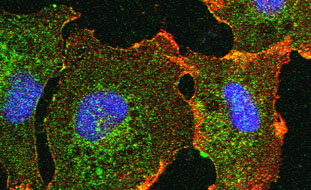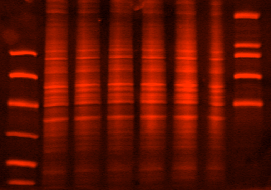



 |
 |
 |
 |
Students:Jillian KidaKatie RaymisJesseca WhitenightShannon Carper |
 |
Metastasis of melanoma from its primary site of origin to distant organ sites remains the principle health threat associated with these disease. The process of melanoma metastasis is a complex one involving the precise coordination of several different cellular events, including the ability of the tumor cell to break away from the primary tumor, invade into underlying layers of the skin, enter the blood stream, travel to a distant organ site, and form a tumor within that site. Our laboratory has been focused on understanding how these cellular events are regulated by investigating various signal transduction pathways which act to increase growth, invasion, migration, and tumor cell plasticity as characterized by vasculogenic mimicry--the unique ability of highly aggressive (prone to metastasis) but not poorly aggressive (not likely to metastasize) melanoma tumor cells to form primitive blood vessel structures and is associated with a poor clinical outcome. Recently, we have identified EphA2, an epithelial cell kinase, and the extracellular regulated kinase 1 and 2 (Erk1/2), a component of the Ras-Raf-Mek1/2-Erk1/2 signal transduction pathway, as promoters of melanoma invasion and vasculogenic mimicry. Current projects in the laboratory are exploring the role of the Ras-Raf-Mek1/2-Erk1/2 pathway in mediating EphA2 expression in aggressive melanoma tumor cells and testing the hypothesis that EphA2 over-expression in aggressive melanoma is the result of the abnormally regulated Ras-Raf-Mek1/2-Erk1/2 pathway and is responsible for promoting metastatic melanoma as characterized by increased cell growth, invasion, migration, and vasculogenic mimicry. Additionally we currently are addressing the feasibility of targeting EphA2 down-regulation in melanoma tumors as a means to decrease melanoma tumor burden and metastasis, thereby establishing EphA2 as a new target for therapeutic intervention, and offering new treatment avenues for patients with this devastating disease.
Hess A.R, N.V. Margaryan, E.A. Seftor, and M.J.C. Hendrix, 2007. Deciphering the signaling events that promote melanoma tumor cell vasculogenic mimicry and their link to embryonic vasculogenesis: Role of the Eph Receptors. Developmental Dynamics 236:3283-3296.
Hess, A.R. and M.J.C. Hendrix. 2006. Focal adhesion kinase signaling and the aggressive melanoma phenotype. Cell Cycle 5(5): 478-480.
Hess, A.R., E.A. Seftor, L.M. Gruman, M.S. Kinch, R.E.B. Seftor and M.J.C. Hendrix. 2006. VE-cadherin regulates EphA2 in aggressive melanoma cells through a novel signaling pathway: implications for vasculogenic mimicry. Cancer Biology and Therapy 5(2): 228-233. (Cover Illustration)
Hess, A.R., L.M. Postovit, E.A. Seftor, N.V. Margaryan, G.B. Schneider, R.E.B. Seftor, B.J. Nickoloff, and M.J.C. Hendrix. 2005. Focal adhesion kinase promotes an aggressive melanoma phenotype. Cancer Research 65(21): 9851-9860.
Hendrix, M.J.C., E.A. Seftor, A.R. Hess, and R.E.B. Seftor. 2003. Vasculogenic mimicry and tumour-cell plasticity: lessons from melanoma. Nature Cancer Reviews 3: 411-421.
Hess, A.R., E.A. Seftor, R.E.B. Seftor, and M.J.C. Hendrix. 2003. Phosphoinositide 3-kinase regulates MT1-MMP and MMP-2 activity during melanoma vasculogenic mimicry. Cancer Research 63: 4757-4762
Hess, A.R., E.A. Seftor, L.M.G. Gardner, K. Carles-Kinch, G.B. Schneider, M.S. Kinch, R.E.B. Seftor, and M.J.C. Hendrix. 2001. Molecular regulation of tumor cell vasculogenic mimicry by tyrosine phosphorylation: role of epithelial cell kinase. Cancer Research 61:3250-3255.
Click here to view my Curriculum Vitae.
| Home | Anatomy and Physiology I | Anatomy and Physiology II | Applied Research | Laboratory |